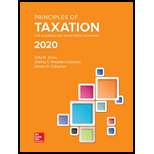
a.
Compute the annual after-tax
b.
Compute the annual after-tax cash flow available for reinvestment in the business, if Person A operates the business as regular (C) corporation and it makes no dividend distributions.
c.
Explain the tax consequences to Person A and the business of the withdrawal in case if the business is operated as a sole proprietorship. Identify the after-tax cash flow would remain for reinvestment in the business and determine the amount after-tax cash flow would Person A have from the withdrawal.
d.
Explain the tax consequences to Person A and the business of a $20,000 withdrawal in the form of a dividend in case it is operated as a C Corporation. Identify the amount of after-tax cash flow would remain for reinvestment in the business. Determine the amount of after-tax cash flow will be retained from the dividend by Person A.
e.
Comment on the given situation for getting the better result.
Want to see the full answer?
Check out a sample textbook solution
Chapter 12 Solutions
Principles Of Taxation For Business And Investment Planning 2020 Edition
- I need help with this general accounting problem using proper accounting guidelines.arrow_forwardGeisner Inc. has total assets of $1,000,000 and total liabilities of $600,000. The industry average debt-to-equity ratio is 1.20. Calculate Geisner's debt-to-equity ratio and indicate whether the company's default risk is higher or lower than the average of other companies in the industry.arrow_forwardI need guidance on solving this financial accounting problem with appropriate financial standards.arrow_forward
- I want to this question answer for General accounting question not need ai solutionarrow_forwardLinton Corp. recently reported an EBITDA of $18.2 million and net income of $3.5 million. It also had interest expense of $2.7 million, and its corporate tax rate is 25%. What was Linton's depreciation and amortization expense?arrow_forwardCan you help me solve this general accounting problem with the correct methodology?arrow_forward
- At September 1, 2010, Kern Enterprises reported a cash balance of $45,000. During the month, Kern collected cash of $15,000 and made disbursements of $25,000. At September 31, 2010, what is the cash balance? A. $25,000 credit B. $35,000 credit C. $60,000 debit D. $35,000 debitarrow_forwardHi expert please given correct answer with general accounting questionarrow_forwardThe total estimated cost for materials and labor are $1,512,000 and $1,984,000, respectively.arrow_forward
- Please provide the solution to this financial accounting question with accurate financial calculations.arrow_forwardWhich approach governs mutual company demutualization accounting? (a) Record at par value (b) Net asset value per share (c) Original membership cost (d) Market value on conversion date MCQarrow_forwardCan you explain this general accounting question using accurate calculation methods?arrow_forward





